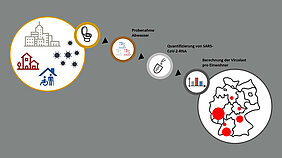TZW research on SARS-CoV-2 in the aquatic environment
On behalf of the DVGW, scientists at TZW evaluated and summarised about 300 studies and other literature on SARS-CoV-2. This provides the current state of knowledge in a clear and scientifically sound manner. In addition, the experts for micro- and molecular biology at the TZW are working on the systematic collection and measurement of wastewater in order to identify possible sources of infection within the scope of monitoring programmes. The detection of SARS-CoV-2 in wastewater could thus serve as an early warning system in the future.
The current COVID-19 pandemic is the focus of public interest. The novel virus can cause a very severe and sometimes fatal respiratory disease. Since the first reports that the novel SARS-CoV-2 is excreted with the stool, there has been growing concern about a possible transmission of this virus via the water pathway. For this reason and based on the suggestion of the DVGW Research Advisory Board on Water Research a literature study was carried out at TZW to summarize the current state of knowledge on the occurrence and behaviour of SARS-CoV-2 in the aquatic environment.
The study confirms the statement that the risk of infection via drinking water is very low. COVID-19 is transmitted from person to person. The main route of transmission is droplet infection in direct contact. The German multi-barrier system consisting of resource protection, water extraction, water treatment and water distribution, provides a safe basis for guaranteeing good water quality. The drinking water is therefore very well protected against all viruses. Based on the fact that SARS-CoV-2 has a membrane envelope, it is assumed that the virus is more easily inactivated in water and is less stable in the environment than enteroviruses or indicator viruses that are monitored regularly.
It is therefore considered highly unlikely that SARS-CoV-2 will spread via the drinking water pathway. At the same time, specific methods are available that can be further developed for a targeted control of drinking water. The evaluation of the scientific literature on clinical diagnostics as well as monitoring in aquatic environments is ongoing and provides the basis for a continuous update of the risk assessment.
On the other hand, the detection of SARS-CoV-2 in wastewater has a high potential for an integral monitoring of COVID-19 infection rates in a catchment area and will be used as an early warning system for increasing infection rates in the future. Therefore, the detection methodology of SARS-CoV-2 in wastewater is currently being established at the TZW.
Publications:
Schriftenreihe Band 93: SARS-CoV-2 im Kontext der Wasserversorgung (in German)
Link to content and order form
> Further information concerning the literature study on DVGW's website

![[Translate to English:] Prüfstelle-Produktprüfung_Teststand Test centre and product testing](/fileadmin/_processed_/0/9/csm_TZW-Karlsruhe_Pruefung_Geraete-Teststand_377188946c.jpg)

























